USS Virginia may refer to:
Six ships of the United States Navy have been named USS Tennessee in honor of the 16th state.
Five United States Navy ships have borne and one future ship will bear the name Atlanta, after the city of Atlanta, Georgia:
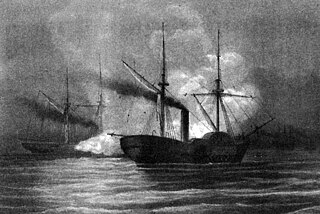
The first USS Hatteras was a 1,126-ton iron-hulled steamer purchased by the Union Navy at the beginning of the American Civil War. She was outfitted as a gunboat and assigned to the Union blockade of the ports and waterways of the Confederate States of America. During an engagement with the disguised Confederate commerce raider, CSS Alabama, she was taken by surprise and was sunk off the coast of Galveston, Texas. The wreck site is one of the few listed on the National Register of Historic Places because of its location away from destructive surf and because of the ship's side-wheel design, which marks the transition between wooden sailing ships and steam-powered ships.
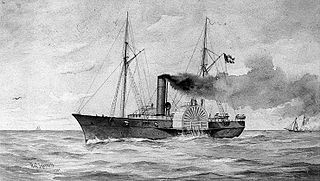
CSS Nashville was a brig-rigged, side-paddle-wheel passenger steamer that served with the Confederate Navy during the Civil War.
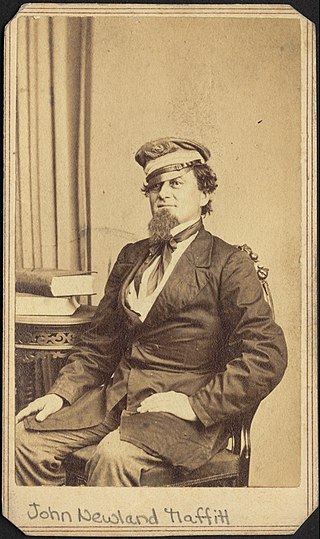
John Newland Maffitt was an officer in the Confederate States Navy who was nicknamed the "Prince of Privateers" due to his success as a blockade runner and commerce raider in the U.S. Civil War.

The Confederate blockade runner CSS Florida, was built at Greenpoint, New York in 1859. Considered for service as a gunboat three times during the American Civil War, the vessel was captured by the Union Navy on April 6, 1862. The ship was taken into service by the Union and renamed USS Hendrick Hudson.

USS Hendrick Hudson was a schooner-rigged screw steamer.
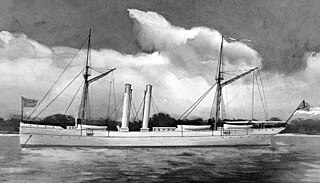
CSS Chickamauga, originally the blockade runner Edith, was purchased by the Confederate States Navy at Wilmington, North Carolina, in September 1864. In September, when she was nearly ready for sea, the Confederate Army sought unsuccessfully to retain her at that place for use as a troop and supply transport. On October 28, 1864, she put to sea under Lieutenant John Wilkinson (CSN) for a cruise north to the entrance of Long Island Sound, thence to St. George, Bermuda, for repairs and coal. She took several prizes before returning to Wilmington on November 19.

The third USS Water Witch was a wooden-hulled, sidewheel gunboat in the United States Navy during the American Civil War. She is best known as the ship fired on by Paraguay in 1855. In 1864 she was captured by the Confederate States Navy, and subsequently was taken into that Navy as CSS Water Witch.
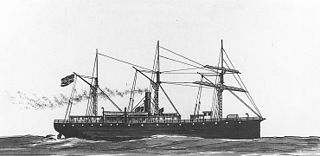
The third USS Montgomery was a wooden screw steamer in the Union Navy during the American Civil War.

CSS Sumter, converted from the 1859-built merchant steamer Habana, was the first steam cruiser of the Confederate States Navy during the American Civil War. She operated as a commerce raider in the Caribbean and in the Atlantic Ocean against Union merchant shipping between July and December 1861, taking eighteen prizes, but was trapped in Gibraltar by Union Navy warships. Decommissioned, she was sold in 1862 to the British office of a Confederate merchant and renamed Gibraltar, successfully running the Union blockade in 1863 and surviving the war.

USS Octorara was a steamer acquired by the Union Navy during the American Civil War. She was used by the Navy to patrol navigable waterways of the Confederacy to prevent the Confederates from trading with other countries.

USS Calhoun was a captured Confederate steamer and blockade runner acquired by the Union Navy from the prize court during the American Civil War.
USS Iron Age was a steamer acquired by the Union Navy during the American Civil War. She was used by the Navy to patrol navigable waterways of the Confederacy to prevent the Confederates from trading with other countries.

USS Isaac Smith was a screw steamer acquired by the United States Navy during the American Civil War. She was used by the Union Navy to patrol navigable waterways of the Confederate States of America to prevent the Confederacy from trading with other countries. In 1863, she became the only warship in the American Civil War to be captured by enemy land forces. She then served in the Confederate States Navy as CSS Stono until she was wrecked.
USS Mobile was a steamer captured by the Union Navy during the American Civil War. She was used by the Union Navy as part of blockade forces to prevent Confederate forces from trading with other countries.
The first USS Adirondack was a large and powerful screw-assisted sloop of war with heavy guns, contracted by the Union Navy early in the American Civil War. She was intended for use by the Union Navy as a warship in support of the Union Navy blockade of Confederate waterways. Her career with the Navy proved to be short, yet active and historically important. USS Adirondack was one of four sister ships which included the Housatonic, Ossipee and Juniata.

During the American Civil War, blockade runners were used to get supplies through the Union blockade of the Confederate States of America that extended some 3,500 miles (5,600 km) along the Atlantic and Gulf of Mexico coastlines and the lower Mississippi River. The Confederacy had little industrial capability and could not produce the quantity of arms and other supplies needed to fight against the Union. To meet this need, British investors financed numerous blockade runners that were constructed in the British Isles and were used to import the guns, ordnance and other supplies, in exchange for cotton that the British textile industry needed greatly. To penetrate the blockade, these relatively lightweight shallow draft ships, mostly built in British shipyards and specially designed for speed, but not suited for transporting large quantities of cotton, had to cruise undetected, usually at night, through the Union blockade. The typical blockade runners were privately owned vessels often operating with a letter of marque issued by the Confederate government. If spotted, the blockade runners would attempt to outmaneuver or simply outrun any Union Navy warships on blockade patrol, often successfully.
This page is based on this
Wikipedia article Text is available under the
CC BY-SA 4.0 license; additional terms may apply.
Images, videos and audio are available under their respective licenses.











